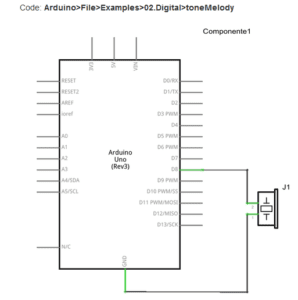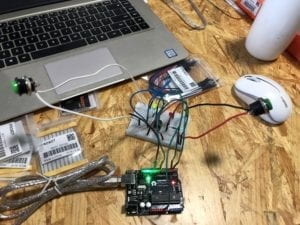Before we arrived at our final project idea, we went through a long way. Our initial idea came from my group project “The smart floor”, in which a floor creates either pleasing visual effect to protect children from crawling around, or scary settings to prevent thieves from breaking into a house. Following the logic of “negative feedback”, I came up with the idea of an interactive piggy bank. The animal-like bank would do spins, sing a song or do other funny things to reward the act of dropping in coins. However, learning that some upperclass students have already created something like that, a battery-eating robot, we decided to move on. We then evolved the idea to a scaring box, then a helmet. Here, my partner and I had trouble reaching an agreement, for we had completely different idea about the purpose of a design, in general. For the sheer joy of it, we built a cat-like helmet, whose eyes would light up and a bamboo dragonfly would rotate once someone puts it on. I could not help laughing when we first tested it, and I insisted on keeping the fundamental logic of the design. Contrarily, my partner considered it too silly, useless and pointless, coming up the idea of a helmet for the blind, which warns them before bumping into an obstacle. However, after consulting with our instructor, we could not explain how our design would outperform a walking stick. What is more, we learned that a design does not necessarily have to be “functional”. We saw a rabbit-like hat, whose ears would move when someone presses the small hand hanging down. From a pragmatism perspective, the hat is of no utility at all, but the sales volumn of it can actually be a five-digit number. It certainly has some value—-it brings fun. Therefore, making clear the goal of our design, we moved straight ahead towards a funny, pleasing, and somewhat decorative helmet.
Although there exist numerous cases of interactive helmet that interacts with people, our design is still unique in some sense. By research, we have found that most helmets lie in the two ends of technology—-either it is the rabbit-like hat that invovles hardly any technology, or it is a neuroelectric helmet, which produces outcome when it senses your brain activity. As is said in an introduction article, it is being researched as a possible way to help with pain, depression, addiction and post-stroke rehabilitation. In other words, it is not for entertainment. Therefore, our helmet would be engaged with technology to a certain extent, and it interacts with people in and outside the helmet. It could be just a toy, or part of a costume for festivals like Holloween.


Once we have reached consensus on our goal, it became clear what materials and methods to choose. Our input would be “digital”. Whether to trigger reactions to the helmet-wearer or the watcher, we need only to know if the person is there or not. In other words, it was a “yes or no” question. Based on this, we chose distance sensors, including an IR sensor for the inside part and an ultrasonic sensor for the outside, for the outside part faces more complexity and requires more accuracy. For devices producing output, we chose three parts—-eyes that would light up, the bamboo dragonfly and a hand that can wave. The criteria here includes relevance to the animal, to what extent it is funny or cute, and whether it can reach the effect with our given electronic devices.
It was not until we actually began to create the project that we realized what was the hardest part. Questions rose one after another—-How should we organize the wires? Where should we place our devices to compromise both the outlook and portability?However, we learned the biggest problem of our design until user test. During user test, everyone read the nametag, waved at the machine and were intrigued by the immediate feedback. But no one realized it was wearable! When I explained that it was actually a helmet, people’s reaction was like “it had better be just a greeting machine”. For, no one would associate it with a helmet, or even if they do, they have no interest in wearing it. Neither the size nor the outlook of our box indicated that it was a helmet. Besides, if the design were to please people, then its outlook had to be pleasing, too. Therefore, we decided that our next move would be to work on the outlook. The trouble was mitigated by laser-cutting a head-sized cardboard. Also, we added more features to it such as ears, nose (ultrasonic ranger) and cheek. It worked to some extent. Everyone who has seen our project before commented, “Now it looks so much nicer!”.
Before closing the reflection, I would like to illustrate more on the goal of our project and room for improvement. Our project is to bring fun to people—-and in some sense, it does. During presentation, someone in other groups answered to the question “why does this project matter”, saying that it could be part of constume that interacts with people during festivals such as the upcoming Holloween. However, it seems to me that we still need to improve on the user experience. If given more time, we will definitely make the helmet more inviting for people to put on. For example, the shape could be round, and we can add handles to it to let users grab it more easily. Also, the helmet is too heavy and fragile, for there are wires, batteries, breadboard and many other things that are not firmly glued to the box, and it could be uncomfortable for the wearer. Therefore, what I take away from the whole experience is to stand in the shoes of users. Every detail in our design has to deliver precisely our idea, and we just cannot assume our user to knoow everything. Even so, I still belive in the fundamental idea of our project—-by being interactive, it brings so much joy to people.
Reference
-
-







